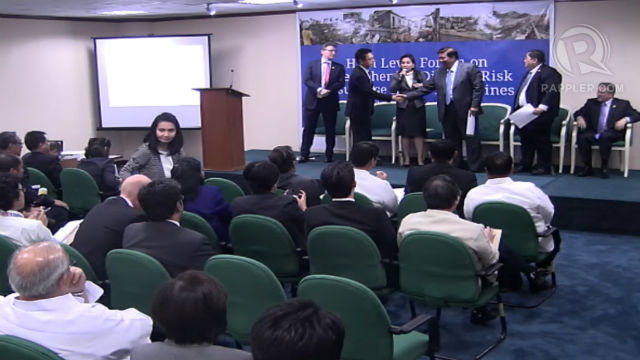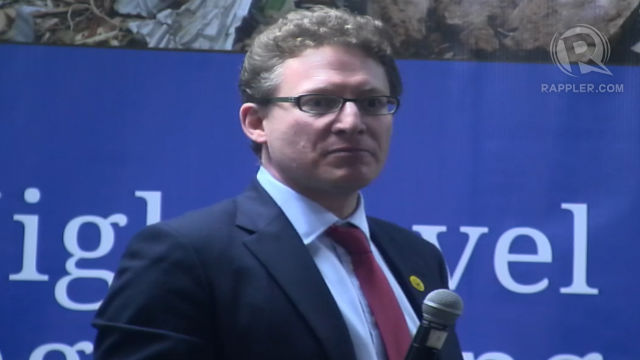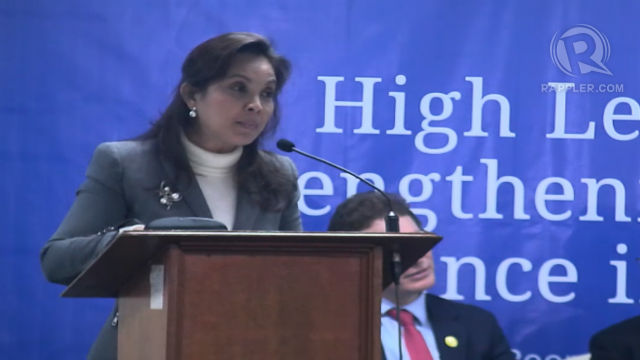SUMMARY
This is AI generated summarization, which may have errors. For context, always refer to the full article.

MANILA, Philippines – What is disaster risk insurance and how does it work? Can it really promote disaster resilience in a country like the Philippines?
These were the questions that government officials, policy makers, and members of the academe and the business sector raised during the high-level forum on strengthening disaster risk insurance on Tuesday, January 21, in an attempt to explore possible models of risk financing for the country.
Disaster or catastrophe insurance is a compensation system that will protect businesses and residences against natural and man-made disasters.
United Nations International Strategy for Disaster Reduction (UNISDR) Advocacy and Outreach chief Jerry Velasquez said the country needs a paradigm shift on disasters “from being reactive to being proactive.”
A disaster insurance system, he said, is one way of focusing on risk reduction and transfer rather than only response.
Despite the big losses the Philippines incurred in past disasters, insurance penetration in the country remains small.
Willis Group CEO Rowan Douglas said insurance is not just about money going in and out but it’s also a shared solution.
“Insurance is the ultimate community product. It’s about agreeing to share the risks…But you have to be connected to the system. You have to be financially included,” Douglas said.
Possible model
Multinational insurance companies Willis Re and Munich Re created the Philippine Risk Insurance Scheme for Municipalities (PRISM), a system that they believe should be mandatory for all local government units (LGUs).
PRISM is a trigger index insurance – payments will be made based on quantifiable data of catastrophes such as wind speed, amount of rainfall or earthquake intensity.
“It is objective as it is based on scientific data…If a certain wind speed, rainfall amount is exceeded, then a predefined payout is triggered…Payment can be made immediately since the places affected by calamities can be determined real time,” Munich Re Climate Center head Ernst Rauch said.
Rauch added that PRISM is based on LGU tax income and that the payout is a percentage of such. It can be a combination of local resources and donor’s money but the beneficiaries will still be the municipalities.

Douglas put emphasis on the need to set up PRISM to all LGUs across the country before the next typhoon season starts. The 2 multinational agencies suggested the system to be put up by June 1.
New legislation?
But not all policy makers and government officials shared Rauch and Douglas’ enthusiasm.
A representative from the Department of Finance (DOF) said an amendment on the current disaster reduction and climate change adaptation legislation might be needed to fast track the implementation of the proposed insurance system.
“You also need to consult all the stakeholders involved. This might not be possible by June 2014,” the representative said.
Climate Change Commission (CCC) secretary Lucille Sering suggested, however, that instead of creating new laws, the current legislation should just be tested.
“We should test the Disaster Risk Reduction and Management (RA 10121) and Climate Change (RA 9729) laws first. There’s no need for new laws…The mechanisms are all in place. Hopefully, we can test them,” Sering commented.
Velasquez also noted that the Philippines already has the best legislation on disaster reduction and climate change. The challenge is to link these laws with capital.
“There is very large opportunities especially because of Yolanda (locally and internationally). We need to harness the interest in DRRM,” he added.
Budget concerns
Sering said that the government has a budget that can be used for such an insurance system. She noted that a P500 – million People’s Safety Fund (PSF) was allotted by the Department of Budget and Management (DBM) under the 2014 national budget.
But senate president Franklin Drilon said getting the budget is not that easy as the P500 million was filed under the unprogrammed fund.
“If the P500 million is under the unprogrammed funds, it cannot be released unless you can loan or find funding,” Drilon said.
Sering noted that there are several loans and sources of funding that are being offered.
“We’re running out of time…The time is ripe for a disaster risk insurance system in the Philippines,” she added.
Senator Loren Legarda, who initiated the event, suggested that instead of getting loans, the target should be to put PSF in the programmed funds for 2015.
Too soon
In his closing speech, Drilon emphasized on the need for an risk insurance system but noted that more deliberation should be done on the issue.
“As a risk management tool, insurance would protect individuals and communities from financial suffering in the aftermath of natural disasters. But we can all agree on the fact that insurance is not a silver bullet for risk management and risk reduction,” Drilon said.
He added, “It is one of the mechanisms to manage or transfer risk, but we need to ask the question: In our investing environment, is it the best course of action in terms of cost effectiveness and affordability?”

Legarda, who is Senate Committee on Climate Change chairperson, said an insurance system would help empower LGUs in DRRM.
“It’s a simple concept. Risk insurance will allow LGUs to have funds and resources. They will not always have to rely on the national government if they’re insured. But of course, the national government’s support will always be needed by LGUs,” Legarda told reporters in Filipino.
Legarda agreed with Drilon that further studies must be conducted on risk insurance.
“It’s a new concept to the Philippines. It’s worth exploring and worth studying to see whether we are ready for it and we will actually benefit from it. What’s important is our awareness of such issue,” Legarda concluded in a mix of Filipino and English. – With reports from Ayee Macaraig/ Rappler.com
Add a comment
How does this make you feel?
![[ANALYSIS] A new advocacy in race to financial literacy](https://www.rappler.com/tachyon/2024/04/advocacy-race-financial-literacy-April-19-2024.jpg?resize=257%2C257&crop_strategy=attention)


![[In This Economy] Can the PH become an upper-middle income country within this lifetime?](https://www.rappler.com/tachyon/2024/04/tl-ph-upper-income-country-04052024.jpg?resize=257%2C257&crop=295px%2C0px%2C720px%2C720px)

There are no comments yet. Add your comment to start the conversation.